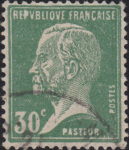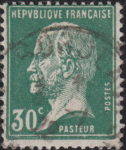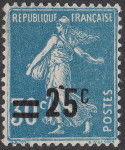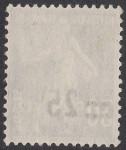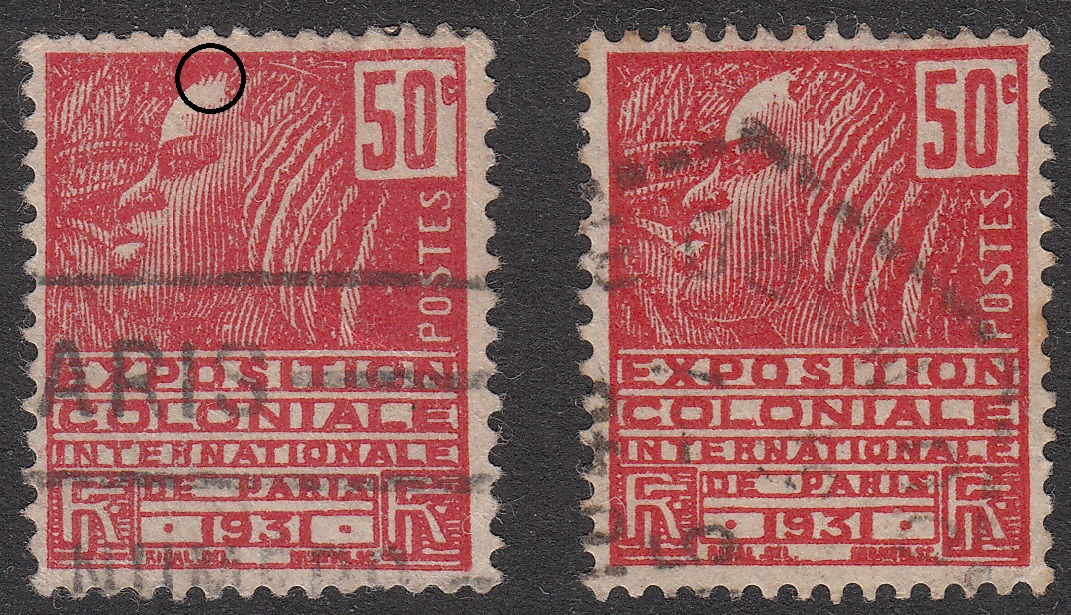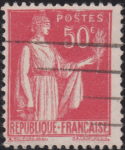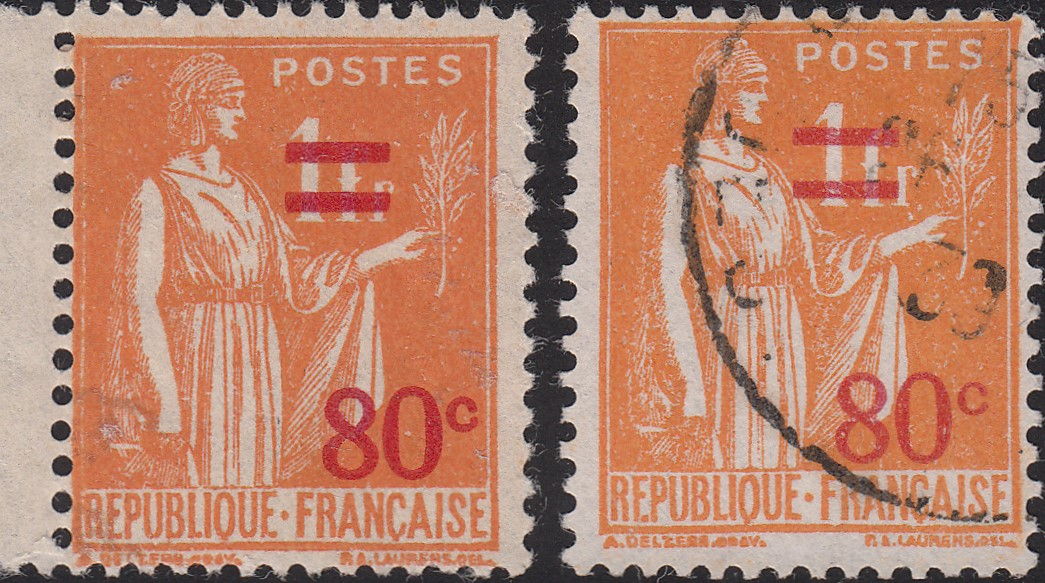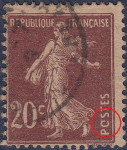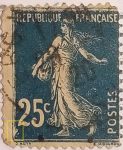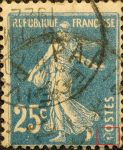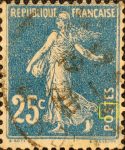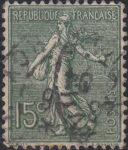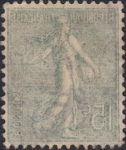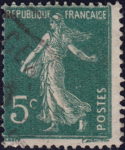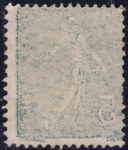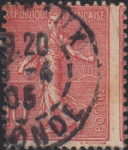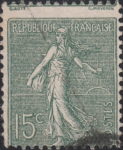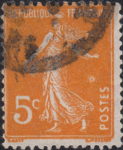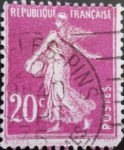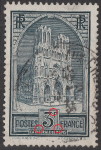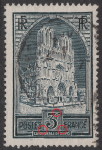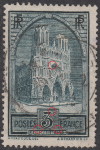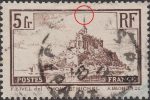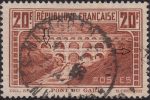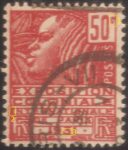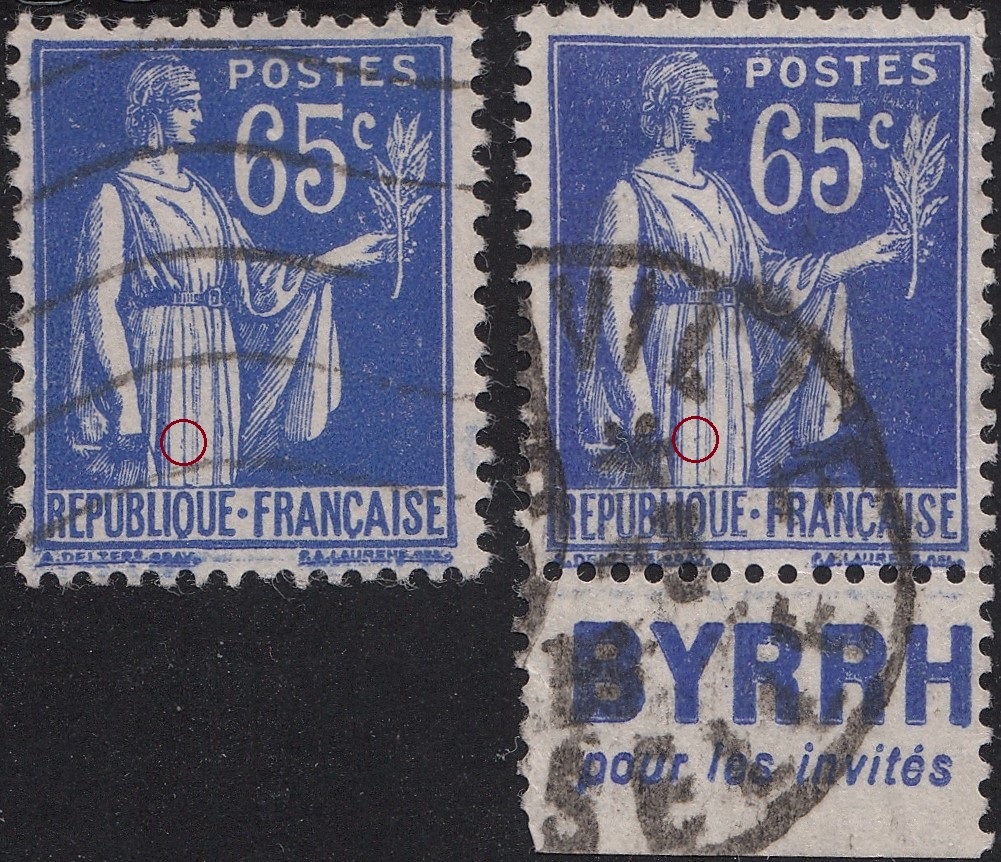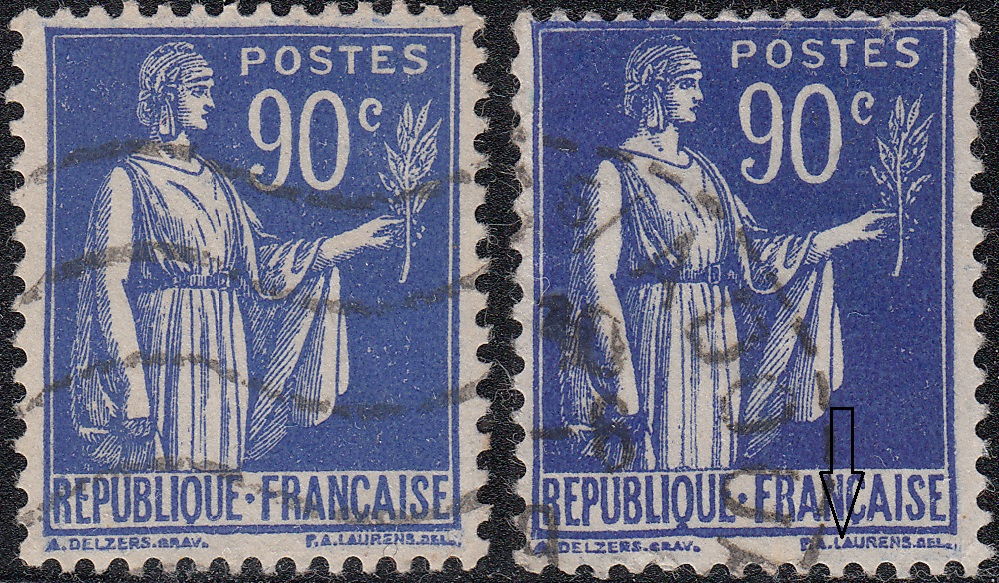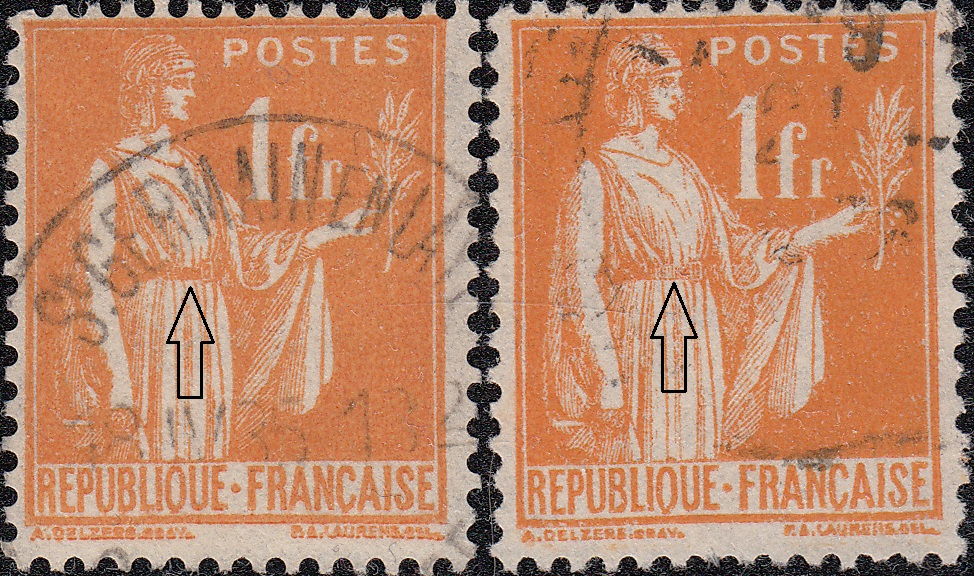| TYPES |
| A: WITH THE SUN AND LINES IN THE BACKGROUND |
| 10 centimes |
- red, 1903, Types I, II and III
Types I, II and III:
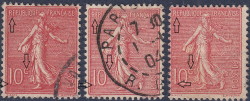 |
Type I:
- the second leg of the letter R in RÉPUBLIQUE with a shade,
- number 1 in denomination oval and curbed,
- interior of letter c in denomination neatly curved.
Type II:
- similar to Type I only letter R in RÉPUBLIQUE without the shade.
Type III:
- numeral 1 in denomination curved on the right,
- interior of the letter C irregular and letter R with a shade.
|
| 15 centimes |
- gray green, 1903, Types I, II, III, IV, V and VI
Types I, II and III:
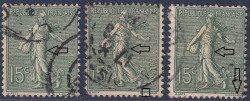
Types IV, V and VI:
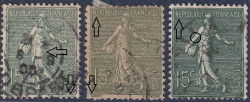
Note: on Grande Consommation, G.C. paper (poor quality,
grayish paper with bits of fiber) were printed types IV and V. |
Type I:
- letter R in RÉPUBLIQUE with a shade,
- line on the Sower’s back is broken,
- letter M in MOUCHON is normal.
Type II:
- similar to Type I, letters M and O in MOUCHON are damaged.
Type: III:
- letter R in RÉPUBLIQUE with a shade,
- line on the Sower’s back is complete,
- letter H in MOUCHON with a dot on the inner side of the second leg.
Type IV (flat plate for sheets and rolls):
- letter R in RÉPUBLIQUE with a shade,
- line on the Sower’s back is complete,
- letter H in MOUCHON is normal,
- letter M in MOUCHON is asymmetrical.
Type V (booklets):
- letter R in RÉPUBLIQUE without a shade,
- line on the Sower’s back is complete,
- the first letter O in O. ROTY in form of a heart.
Type VI (rotary press for rolls):
- letter R in RÉPUBLIQUE without a shade,
- height of the image: 22,5 mm,
- four lines on left hand.
|
| 50 centimes |
- dark blue, 1921/22, Type I (all stamps are of this type)
- olive green, January 1926, Types I, II and III*
- red, September 1926, Types I, II, III, IV
Types I, II, III and IV:

* Note: Although not listed in available literature,
olive green Type III was also found. |
Type I (sheets and the first flat plate booklets):
- a dot on the cap,
- eyelets of both R’s in country name are equal,
- eyelets of both A’s in FRANÇAISE are normal,
- eyelets of both A’s in FRANÇAISE are normal,
- eyelets of letter B in RÉPUBLIQUE are almost equal.
Type II (rotary sheets, second booklets and second rotary booklets):
- eyelet of R in RÉPUBLIQUE is larger than the eyelet of R in FRANÇAISE,
- the lower eyelet of letter B in RÉPUBLIQUE is larger than the upper,
- eyelets of letters A in FRANÇAISE are tiny.
Type: III (rolls):
- similar to Type II, no shading below letter R in RÉPUBLIQUE.
Type IV (first rotary booklets):
- letter R in RÉPUBLIQUE without a shade,
- interior frame on the left is thick,
- background behind RÉPUBLIQUE appears to be flat.
|
| 75 centimes |
- rose lilac, November, 10th 1926, Types I and II
Type I:
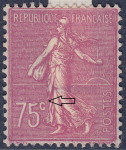 |
Type I:
- single line between the Sower’s belt and letter c in denomination.
Type II:
- two lines between the belt and the letter c,
- letter c in denomination without a shade,
- numeral 7 in denomination more cambered.
|
| B: FLAT BACKGROUND, WITH GROUND UNDER FEET |
| 10 centimes |
- red, April, 16th 1906, Types I and II
Types I and II:
 |
Type I:
- lines representing shades are thicker making the figure darker.
Type II:
- shading is light, the figure appears to be lighter.
|
| C: FLAT BACKGROUND, THIN INSCRIPTIONS |
| 10 centimes |
- red, June, 28th 1926, Types I and II
Types I, II and III:
 |
Type I:
- contour of Sower and sack very thin.
Type II:
- the contour is thicker, the Sower and the sack are standing out.
Type III:
- the last letter E in RÉPUBLIQUE touching the figure’s front hair.
|
| D: FLAT BACKGROUND, THICK INSCRIPTIONS |
| 5 centimes |
- green, Types I and IIA
- orange, Types I, IIA and IIB
Types I and IIA:
 |
Type I:
- the bottom of letter Q in RÉPUBLIQUE in form of a dot.
Type IIA:
- the bottom of letter Q in form of a vertical line.
|
| 10 centimes |
- red (1907), Types IA, IC and II
- green (1921/22), Types IA, IB, IC, III and IV
Types IA, IB and IC:
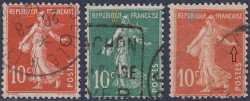
Types II and III:
 |
Type IA (sheets and rolls, flat plate):
- the bottom of the letter Q in RÉPUBLIQUE in form of a vertical line,
- middle horizontal line in letter B in RÉPUBLIQUE is straight,
- hatching in the sowing hand normal.
Type IB:
- the bottom of the letter Q in RÉPUBLIQUE in form of a dot,
- middle horizontal line in letter B in RÉPUBLIQUE is straight,
- hatching in the sowing hand normal.
Type IC (booklets of 20):
- middle horizontal line in letter B is oblique,
- the third hatching in the sowing hand is broken.
Type II (booklets of 30 and sheets of 144):
- letter Q in RÉPUBLIQUE with a big dot and R in RÉPUBLIQUE with equally long legs.
Type III:
- letter c in denomination rounded with the lower part shorter than the upper.
Type IV:
- letter c in denomination rounded the lower part longer than the upper.
|
| 15 centimes |
- red brown, 1926, Types I and II
Types I and II:
 |
Type I:
- numeral 1 is thinner,
- horizontal line on numeral 5 finishes with an inverted triangle.
Type II:
- numeral 1 is thicker,
- horizontal line on numeral 5 finishes with a vertical line.
|
| 20 centimes |
- violet brown, December, 18 1907, Types I, III and IV
- lilac, July, 20 1926, Types III, IV, V and VI
Types I, III, IV and V:
 |
Type I (all stamps on paper GC):
- image dimensions: 18×22 mm.
Type III:
- image dimensions: 18½ x 22½,
- a line and a dot on sower’s belt.
Type IV:
- similar to Type III but without a line and a dot on the belt.
Type V:
- lower left part of numeral 2 long and thin, almost touching the frame.
Type VI:
- similar to Type IV, the stamp is larger.
Note: Type II doesn’t exist. |
| 25 centimes |
- blue: June, 19 1907, Types IA, IB, II, IIIA, IIIB, IIIC and IV
- brown orange: June 1927, Types IIIB and IIIC
Types I, II and IIIA:
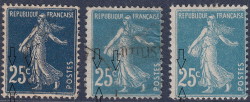
Types IIIB, IIIC and IV:  |
Type I:
- the upper part of letter c in denomination almost horizontal,
- head of numeral 2 less bent,
- horizontal line of numeral 2 thin and curvy.
Type II (booklets):
- letter c in denomination barred,
- head of numeral 2 more bent,
- horizontal line of numeral 2 thicker and less curvy.
Type IIIA:
- left internal frame thick and irregular,
- letter c in denomination not barred,
- head of numeral 2 more bent,
- horizontal line in numeral 2 thick but well curvy.
Type IIIB:
- like IIIA but the frame is thin and the image higher.
Type IIIC (rolls):
- like IIIB, vertical and sloping lines in letter R in FRANÇAISE forming acute angle.
Type IV (booklets):
- letter c in denomination like in Type I,
- head of numeral 2 more bent,
- horizontal line of numeral 2 thicker than Type I but more curvy.
|
| 30 centimes |
- orange: May, 25th 1907, Type I
- red: January 1922, Type I
- blue: July 1925, Types IIA, IIB and IIC
- cerise: January 6th, 1925, Types I, IIA and IIB
- copper red: November 17th, 1937, Types IIA and III
Types I, IIA and IIB:
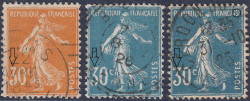
Types IIA and III:
 |
Type I:
- horizontal line of numeral 3 short, measuring 1¾ mm.
Type IIA:
- horizontal line of numeral 3 long, measuring 2¼ mm,
- letter S in FRANÇAISE short.
Type IIB:
- similar to Type IIA, letter S in FRANÇAISE longer.
Type III:
- numeral 3 in denomination thinner, its loop is closed,
- zero in denomination thin.
|
| 40 centimes |
- olive brown: August 1925, Types I and II
- vermilion: May 25th, 1926, Types I and II
- violet: September 1927, Type II
- ultramarine: December 1928, Type II
Types I and II:
 |
Type I:
- two extremities of letter c in denomination on the same vertical,
- the left sloping line of numeral 4 is convex.
Type II:
- the lower extremity of letter c in denomination is longer,
- the left sloping line of numeral 4 is straight.
|



